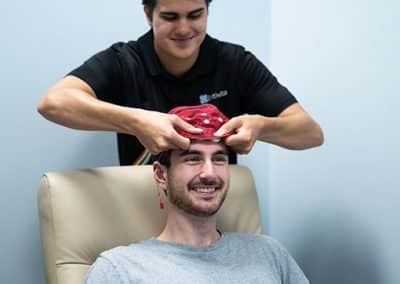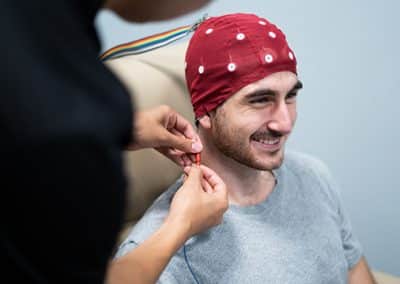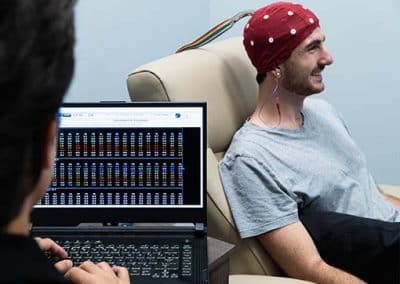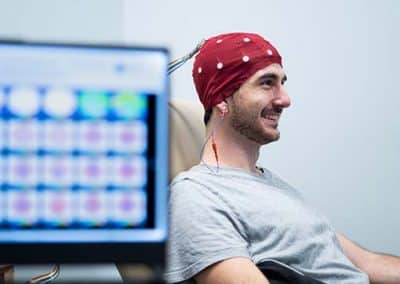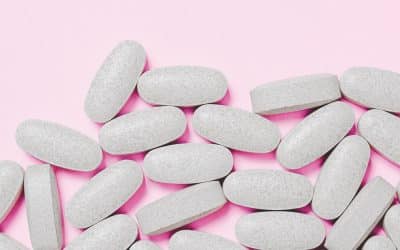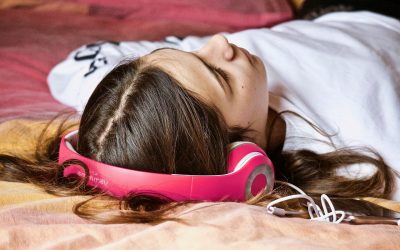Insomnia
HBOT- Hyperbaric Oxygen Therapy (HBOT) may help with insomnia by increasing oxygen delivery to the brain and improving brain function. HBOT enhances oxygen levels in the blood, which can improve brain tissue health and help regulate sleep patterns. It also has anti-inflammatory effects, which may reduce inflammation-related insomnia (1). Additionally, HBOT may regulate neurotransmitters like serotonin and dopamine, which are important for sleep, and reduce stress and anxiety by improving blood flow and oxygenation (2) . For those with brain injuries or conditions, HBOT can support brain healing and lead to better sleep.
Extivita Therapies for Insomnia:

HBOT

IV Therapy

Infrared Sauna

PEMF Therapy

Neurofeedback
Neurofeedback Therapy for Insomnia:
Insomnia has significant effects on the brain, impairing cognitive functions like attention, memory, and decision-making, while also disrupting emotional regulation (3). Chronic sleep deprivation increases the risk of cognitive decline and neurodegenerative diseases, including Alzheimer’s and Parkinson’s (3). One key issue is that insufficient sleep hampers the brain’s ability to clear metabolic waste, including beta-amyloid—a protein linked to Alzheimer’s. This buildup of waste products further raises the risk of these conditions (4).
Neurofeedback is a promising, non-invasive technique that can help treat insomnia by training the brain to regulate its activity. It works by monitoring brainwave patterns in real-time and providing feedback to encourage the production of relaxing brainwaves, which are crucial for good sleep. Neurofeedback helps restore healthy sleep cycles, reduces stress and anxiety, and promotes more restful sleep, offering a drug-free alternative for managing chronic insomnia(5).
Nutritional IV Therapy for Insomnia:
Myers cocktail and NAD+ infusions may help patients with insomnia. Myers Cocktail and NAD+ infusions may offer potential benefits for patients with insomnia by addressing underlying factors such as inflammation and cellular health. The Myers Cocktail, which includes vitamin C and magnesium, can help reduce inflammation—a condition often linked to insomnia—by neutralizing free radicals and lowering oxidative stress (6). Magnesium, another key component, is known to promote relaxation and improve sleep quality by calming the nervous system (7). NAD+ infusions enhance cellular energy production and repair processes, potentially benefiting sleep by supporting the function of mitochondria and reducing neuroinflammation (8). NAD+ also plays a role in regulating the circadian rhythm, which could help stabilize sleep patterns (9).

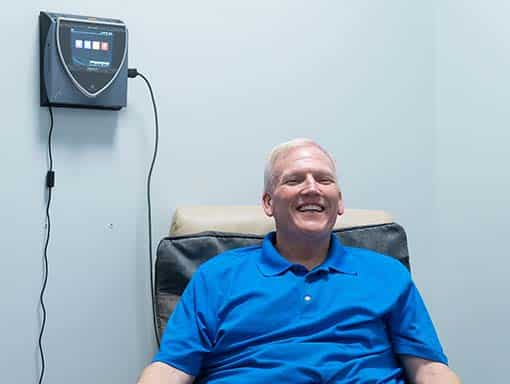
Pulsed Electromagnetic Field Therapy for Insomnia:
Pulsed Electromagnetic Field (PEMF) therapy may help modulate brain activity and neurochemical processes related to sleep regulation, making it a promising non-pharmacological option for managing insomnia. PEMF therapy can benefit patients with insomnia by promoting relaxation, improving sleep quality, and reducing factors that disrupt sleep, such as pain or discomfort. It works by using electromagnetic fields to stimulate and heal the body’s cells, helping to regulate circadian rhythms and support the natural sleep cycle. Research suggests that PEMF therapy may enhance melatonin production—a hormone critical for regulating sleep—and lower cortisol levels, a stress hormone linked to sleep disturbances (10,11). Additionally, PEMF therapy has been shown to improve blood flow and oxygenation in tissues, which contributes to overall relaxation and aids in achieving restorative sleep (12). A recent randomized controlled, double-blind study further supports PEMF therapy’s potential for treating insomnia, finding that individuals who received PEMF therapy experienced significant improvements in sleep quality, reduced time to fall asleep, and increased time spent in restorative sleep stages (13).
Infrared Sauna Therapy for Insomnia:
Infrared sauna therapy may help patients with insomnia by promoting relaxation, reducing stress, and improving sleep quality. The heat from an infrared sauna penetrates the skin more deeply than traditional saunas, which can help increase blood circulation and promote muscle relaxation. This deep relaxation effect can lower cortisol levels, the body’s primary stress hormone, which is often elevated in people with insomnia. Additionally, infrared sauna use can enhance the release of endorphins, which are natural mood enhancers, potentially leading to better sleep quality and duration (14). Some studies also suggest that the gentle heat from infrared saunas can help regulate the autonomic nervous system, promoting a state conducive to restful sleep (15).

News & Research for Insomnia:
The Effects of Magnesium – Melatonin – Vit B Complex Supplementation in Treatment of Insomnia
Abstract Insomnia means difficulty in falling asleep and/or stays asleep. Insomnia commonly leads to daytime sleepiness, lethargy, and a general feeling of being unwell. The most common treatment of insomnia includes GABAA receptor positive allosteric modulators or...
The medicalization of sleeplessness: Results of U.S. office visit outcomes, 2008-2015
Previous analysis of U.S. physician office visits (1993-2007) indicated that the medicalization of sleeplessness was on the rise and had potentially negative implications for population health. Our study asks if the medicalization of sleeplessness at the level of patient-physician interaction has persisted over time. Using the most recent years available (2008-2015) of the National Ambulatory Medical Care Survey we calculated nationally representative estimates for four sleeplessness-related outcomes of physician office visits: sleeplessness complaint, insomnia diagnosis, and prescription of benzodiazepine and non-benzodiazepine sedative-hypnotics (NBSH).
Sleep, Sleep Disorders, and Circadian Health following Mild Traumatic Brain Injury in Adults: Review and Research Agenda
Abstract A rapidly expanding scientific literature supports the frequent co-occurrence of sleep and circadian disturbances following mild traumatic brain injury (mTBI). Although many questions remain unanswered, the preponderance of evidence suggests that sleep and...
Resources:
- Prather, Aric A et al. “Sleep duration, insomnia, and markers of systemic inflammation: results from the Netherlands Study of Depression and Anxiety (NESDA).” Journal of psychiatric research vol. 60 (2015): 95-102. doi:10.1016/j.jpsychires.2014.09.018
- Miller, Andrew H et al. “Inflammation and its discontents: the role of cytokines in the pathophysiology of major depression.” Biological psychiatry vol. 65,9 (2009): 732-41. doi:10.1016/j.biopsych.2008.11.029
- Dimitriu, Alex. “How Sleep Impacts Cognition, Memory, and Dementia.” Psychology Today, Sussex Publishers, 20 Feb. 2023, www.psychologytoday.com/intl/blog/psychiatry-and-sleep/202302/how-sleep-impacts-cognition-memory-and-dementia.
- Wennberg, Alexandra M V, et al. “Sleep Disturbance, Cognitive Decline, and Dementia: A Review.” Seminars in Neurology, U.S. National Library of Medicine, 24 Aug. 2017, www.ncbi.nlm.nih.gov/pmc/articles/PMC5910033/.
- Lambert-Beaudet, Florence, et al. “Neurofeedback for Insomnia: Current State of Research.” World Journal of Psychiatry, U.S. National Library of Medicine, 19 Oct. 2021, www.ncbi.nlm.nih.gov/pmc/articles/PMC8546766/.
- Harrison, F. E., & May, J. M. (2021). Vitamin C function in the brain: vital role of the ascorbate transporter SVCT2. Neurochemical Research, 36(1), 67-73.
- Abbasi, B., Kimiagar, M., Sadeghniiat, K., Shirazi, M. M., Hedayati, M., & Rashidkhani, B. (2012). The effect of magnesium supplementation on primary insomnia in elderly: A double-blind placebo-controlled clinical trial. Journal of Research in Medical Sciences: The Official Journal of Isfahan University of Medical Sciences, 17(12), 1161.
- Yaku, K., Okabe, K., & Nakagawa, T. (2018). NAD metabolism: Implications in aging and longevity. Ageing Research Reviews, 47, 1-17.
- Ramsey, K. M., Yoshino, J., Brace, C. S., Abrassart, D., Kobayashi, Y., Marcheva, B., … & Bass, J. (2009). Circadian clock feedback cycle through NAMPT-mediated NAD+ biosynthesis. Science, 324(5927), 651-654.
- Fitzsimmons, R. J., Gordon, S. L., Kronberg, J., & Ganey, T. M. (1992). Effect of pulsed electromagnetic fields on collagen production in mouse fibroblasts. Orthopaedic Research Society, 35(2), 289-294.
- Sandyk, R. (1992). Application of weak electromagnetic fields to the treatment of neuropsychiatric disorders. Neurobiology, 1(2), 17-20.
- Rohde, C., Chiang, A., Adipoju, O., Casper, D., & Pilla, A. A. (2015). Effects of pulsed electromagnetic fields on IL-1β and postoperative pain: a double-blind, placebo-controlled, pilot study in breast reduction patients. Plastic and Reconstructive Surgery, 135(6), 879e-887e.
- Liao, Jiwu et al. “Efficacy and Safety of Pulse Magnetic Therapy System in Insomnia Disorder: A Multicenter, Randomized, Double-Blind, Placebo-Controlled Trial.” Psychiatry investigation 20,6 (2023): 559-566. doi:10.30773/pi.2022.0362
- Beever, R. (2009). Far-infrared saunas for treatment of cardiovascular risk factors: A review of the literature. Canadian Family Physician, 55(7), 691-696.
- Nishi, H., Homma, S., Kondo, T., & Imaizumi, K. (2007). Effects of repeated thermal therapy for patients with chronic pain. Psychotherapy and Psychosomatics, 76(5), 298-304.

